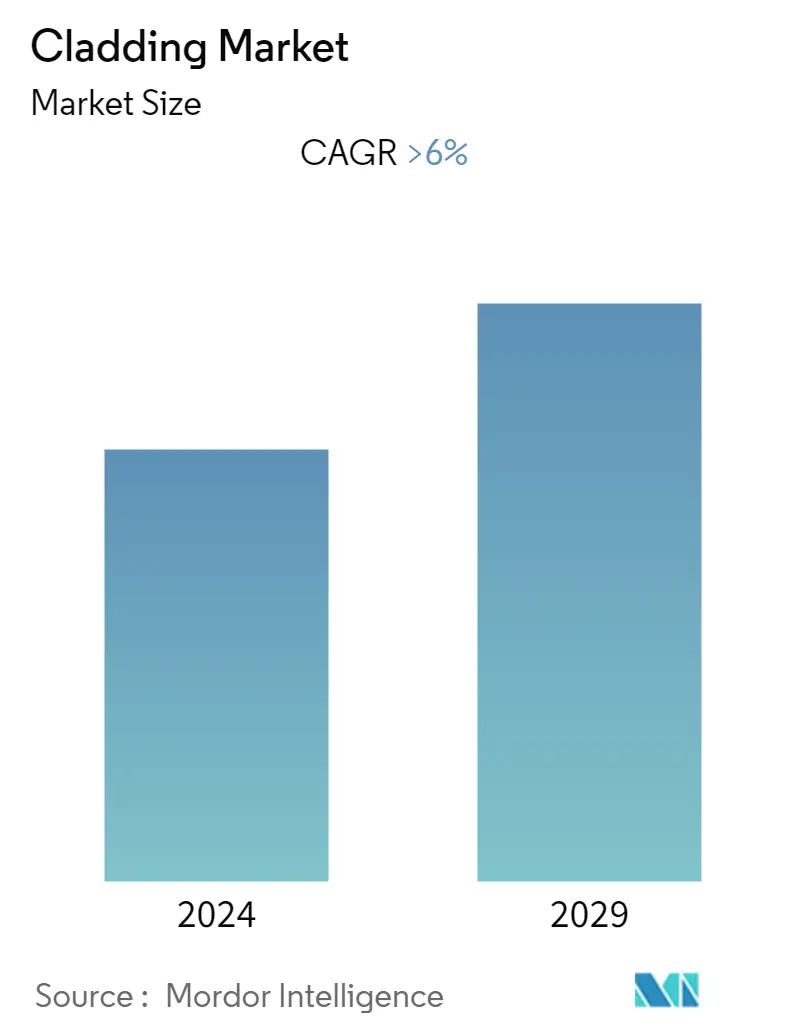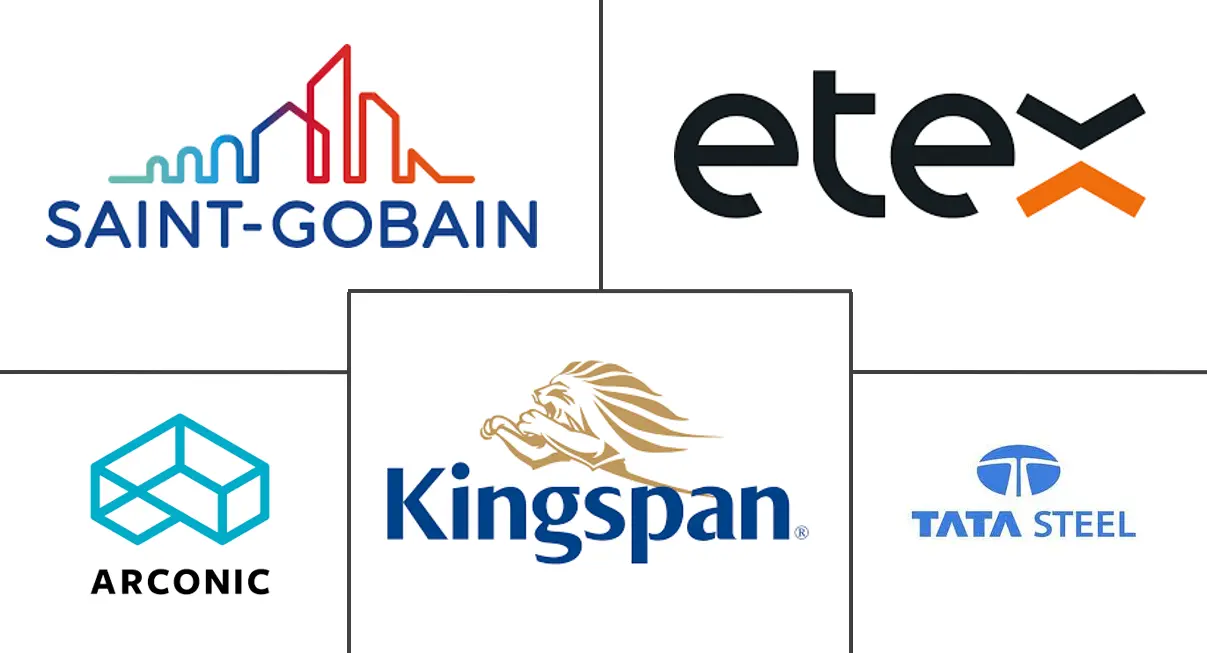Market Size of Cladding Industry

| Study Period | 2020 - 2029 |
| Base Year For Estimation | 2023 |
| Forecast Data Period | 2024 - 2029 |
| CAGR (2024 - 2029) | 6.00 % |
| Fastest Growing Market | Asia-Pacific |
| Largest Market | North America |
Major Players
*Disclaimer: Major Players sorted in no particular order |
Cladding Systems Market Analysis
The Cladding Market is expected to register a CAGR of greater than 6% during the forecast period(2024-2029).
The construction industry was significantly and negatively impacted by COVID-19. The limitations put in place by the government to stop the virus's spread and effects hindered project development and had a bad effect on manufacturers, supply chains, equipment, materials, and labor. This crisis hampered the growth of the construction industry, which in turn restrained the demand for cladding.
Because the construction industry is growing around the world, the cladding market is expected to grow steadily over the next few years. The product helps to improve a building's energy efficiency, which means that less energy is needed for heating, cooling, and ventilation. One of the primary factors driving market growth is the increased demand for energy-efficient construction solutions.
Cladding keeps the outside and inside environments of a building in balance and is made to meet both aesthetic and functional needs. Cladding is done in accordance with the building's operational requirements. The expansion of infrastructure and construction activities in residential and non-residential spaces around the world are drivers of the cladding market.
Stringent government regulations, green building regulations, and codes such as LEED certifications are also propelling investments in lightweight and energy-efficient market cladding systems in residential and non-residential buildings.
The demand for fire resistance, thermal resistance, water resistance, and soundproof cladding systems is growing. Innovative, eco-friendly cladding materials are preferred in the market as consumers have become more environmentally concerned. The high cost of the cladding system and materials may restrain the growth of the market. Customers in the market are opting for vertical gardens on their exterior walls to create a sustainable yet attractive look. This is further leading to the development of artificial green walls with a natural look, which reduces the need for watering and maintenance.
Cladding Systems Industry Segmentation
The exterior of a structure is covered with panels made of a different material during the cladding process. Buildings are constructed using cladding systems. The cladding market report provides an overview of the market with an exhaustive analysis of current advancements in the market. The report also focuses on the trends in production and consumption data for the product, policies and plans, cost structures, and manufacturing processes. Moreover, the company profiles of the key manufacturers, along with a thorough analysis, are also provided.
The Metal Cladding Market Is Segmented By Material (Metal, Terracotta, Fiber Cement, Concrete, Ceramics, Wood, Vinyl, And Other Materials), By Component Type (Wall, Roofs, Windows, And Doors), By Application (Residential, Non-Residential), And By Geography (North America, Europe, Asia-Pacific, South America, And The Middle East And Africa). The Market Size And Forecasts Are Provided In Terms Of Value (USD) For All The Above Segments.
| By Material | |
| Metal | |
| Terracotta | |
| Fiber Cement | |
| Concrete | |
| Ceramics | |
| Wood | |
| Vinyl | |
| Other Materials |
| By Component Type | |
| Wall | |
| Roofs | |
| Windows and Doors | |
| Other Component Types |
| By Application | |
| Residential | |
| Non-residential |
| By Geography | ||||||||
| ||||||||
| ||||||||
| ||||||||
| ||||||||
|
Cladding Market Size Summary
The cladding systems market is poised for steady growth, driven by the expanding construction industry worldwide. As the demand for energy-efficient and sustainable building solutions rises, cladding systems are increasingly favored for their ability to enhance energy efficiency and provide aesthetic appeal. The market is influenced by stringent government regulations and green building standards, such as LEED certifications, which encourage the use of lightweight and energy-efficient materials in both residential and non-residential buildings. Despite challenges such as high costs and the need for innovative materials, the market is witnessing a shift towards eco-friendly options, including vertical gardens and artificial green walls, which cater to the growing environmental consciousness among consumers.
Regionally, the North American cladding market is expected to experience significant growth due to increased housing demand and government initiatives to improve social infrastructure. Meanwhile, the Asia-Pacific region is anticipated to grow at the fastest rate, fueled by rapid urbanization and rising construction activities in countries like China and India. In Europe, the demand for cladding is expected to rise with the increase in commercial building projects. The Middle East and Africa are also projected to see a rebound in construction activities, further driving the demand for cladding systems. The market is competitive, with key players like Arconic Inc., Tata Steel Ltd., and Kingspan Group innovating and expanding through strategic acquisitions to meet diverse market demands.
Cladding Market Size - Table of Contents
-
1. MARKET INSIGHTS
-
1.1 Market Overview
-
1.2 Market Drivers
-
1.3 Market Restraints
-
1.4 Value Chain / Supply Chain Analysis
-
1.5 Porter's Five Forces Analysis
-
1.5.1 Bargaining Power of Buyers/Consumers
-
1.5.2 Bargaining Power of Suppliers
-
1.5.3 Threat of New Entrants
-
1.5.4 Threat of Substitute Products
-
1.5.5 Intensity of Competitive Rivalry
-
-
1.6 Insights on Trends in the Construction and Cladding Market
-
1.7 Insights on Technological Disruptions in the Market
-
1.8 Insights on Government Regulations in the Market
-
1.9 Insights on Impact of COVID-19 on the Market
-
-
2. MARKET SEGMENTATION
-
2.1 By Material
-
2.1.1 Metal
-
2.1.2 Terracotta
-
2.1.3 Fiber Cement
-
2.1.4 Concrete
-
2.1.5 Ceramics
-
2.1.6 Wood
-
2.1.7 Vinyl
-
2.1.8 Other Materials
-
-
2.2 By Component Type
-
2.2.1 Wall
-
2.2.2 Roofs
-
2.2.3 Windows and Doors
-
2.2.4 Other Component Types
-
-
2.3 By Application
-
2.3.1 Residential
-
2.3.2 Non-residential
-
-
2.4 By Geography
-
2.4.1 North America
-
2.4.1.1 United States
-
2.4.1.2 Canada
-
2.4.1.3 Mexico
-
2.4.1.4 Rest of North America
-
-
2.4.2 Europe
-
2.4.2.1 Germany
-
2.4.2.2 United Kingdom
-
2.4.2.3 France
-
2.4.2.4 Russia
-
2.4.2.5 Spain
-
2.4.2.6 Rest of Europe
-
-
2.4.3 Asia-Pacific
-
2.4.3.1 India
-
2.4.3.2 China
-
2.4.3.3 South Korea
-
2.4.3.4 Japan
-
2.4.3.5 Rest of Asia-Pacific
-
-
2.4.4 South America
-
2.4.4.1 Brazil
-
2.4.4.2 Argentina
-
2.4.4.3 Rest of South America
-
-
2.4.5 Middle-East and Africa
-
2.4.5.1 United Arab Emirates
-
2.4.5.2 Saudi Arabia
-
2.4.5.3 Rest of the Middle-East and Africa
-
-
-
Cladding Market Size FAQs
What is the current Cladding Market size?
The Cladding Market is projected to register a CAGR of greater than 6% during the forecast period (2024-2029)
Who are the key players in Cladding Market?
Arconic Inc., Tata Steel Ltd., Etex Group, Compagnie de Saint Gobain SA. and Kingspan Group are the major companies operating in the Cladding Market.

